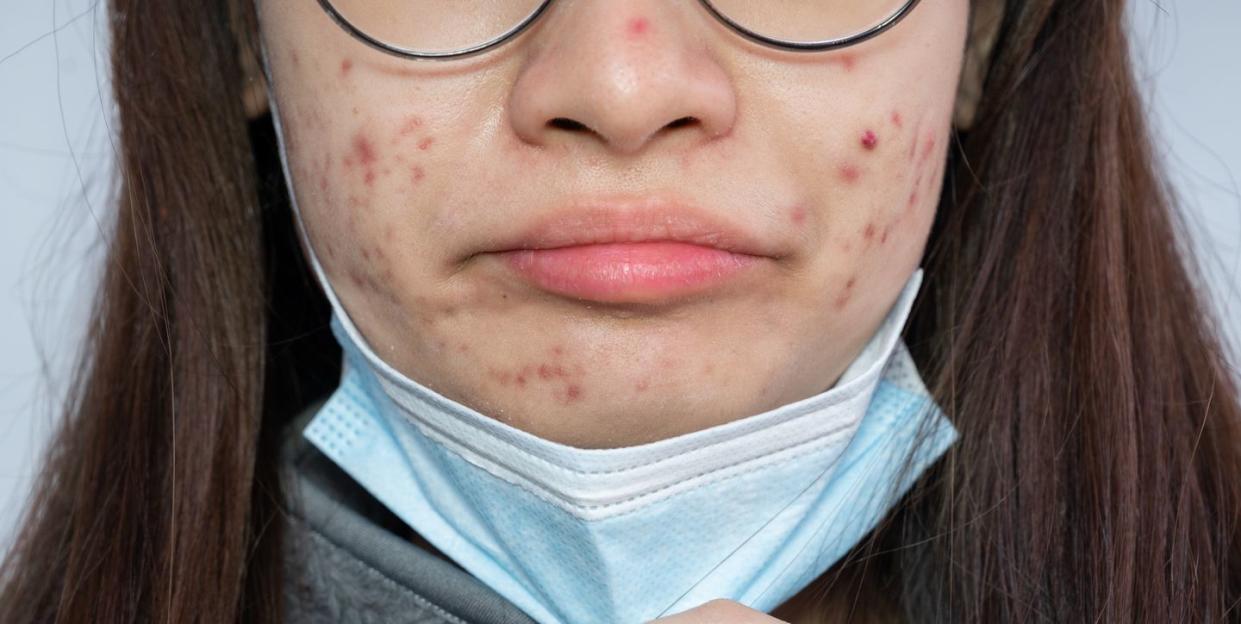These Dermatologist Maskne Tips Will Help You Beat Breakouts for Good

"Hearst Magazines and Yahoo may earn commission or revenue on some items through the links below."
Though adult acne isn’t anything new, more and more adults long past their teen years are reporting pimples—and it’s likely due to wearing a face mask. While mask-wearing is an essential part of controlling the spread of the coronavirus, experts agree they’ve seen an influx of mask-related acne, called maskne.
“I recently polled a small group of board-certified dermatologists and asked them if they’d seen a spike in acne-related complaints since the beginning of the pandemic. More than half of them said yes,” says Robin Schaffran, M.D., chief dermatologist and co-founder of BalmLabs.
And while chin acne is a growing issue, it’s also important to note that acne isn’t the only skin condition that masks can cause. Dr. Schaffran adds that irritation dermatitis (like eczema) can pop up causing redness, peeling, and flakiness. Additionally, perioral dermatitis, which looks like red bumps around the nose, mouth, and sometimes under the eyes, can happen from the lack of breathability of masks, adds Heather Richmond, M.D., F.A.A.D., board-certified medical and cosmetic dermatologist in Texas.
Be sure to see your dermatologist if you’re experiencing any mask-related skin issues you can’t control on your own for the best treatment. But first, we asked experts how to identify maskne, how to prevent maskne, and the best maskne treatments on the market.
Maskne symptoms
Your skin naturally builds up sweat and oil throughout the day, and pair that with the humidity from breathing into the mask and the mask rubbing on your skin, and you’re likely to have some skin trouble, explains Dr. Schaffran. Masks can cause your skin’s natural pH to change, encouraging bacterial and yeast overgrowth, irritation, clogged pores, and an increase in acne breakouts, she says.
If you’re finding the area covered by your mask—lower cheeks, chin, lips, jaw, and nose—are suddenly breaking out, that’s likely maskne, says Dr. Schaffran. Depending on your skin type, this can present itself as inflammatory papule and pustules (small pimples), acne cysts (deep pimples), and/or blackheads, says Dr. Richmond. These can appear in clusters or just one or two at a time, adds Heather Rogers, M.D., F.A.A.D, a board-certified dermatologist in California. She notes if you have oily skin, you’re likely more prone to whiteheads and smaller pimples, while dry, sensitive skin will likely see more of a rashy irritation.
Additionally, you may be experiencing breakouts that aren’t even related to the masks specifically, but just the stress of the new normal, says Dr. Rogers. If you’re finding deep cystic pimples, you may have your hormones (specifically, the stress hormone cortisol) to blame, she adds.
Maskne prevention
Experts agree that the most important thing you can do to prevent maskne is to keep your mask and your face clean. Wash your face with a good face wash and moisturize every night, Dr. Rogers encourages.
Keep your face free of greasy products that may make maskne worse and opt for oil-free versions of sunscreens and moisturizers, Dr. Schaffran says. You can choose mineral makeup or go makeup-free for better results, Dr. Richmond adds.
You’ll also want to help support a healthy skin barrier as best as you can. Dr. Schaffran explains, the outermost layer of skin, which is made up of ceramides and fatty acids, plays an important role in protecting your skin from irritants and bacteria. This layer weakens as we age, so it’s essential to apply a lightweight, oil-free moisturizer to keep your skin healthy.
When it comes to keeping your mask clean, most mask materials will likely build up bacteria the same. If you want to try some different options, Dr. Schaffran suggests opting for a silk mask for acne-prone skin or a disposable mask or surgical mask for a fresh mask every time you head out the door. Be aware that a thinner or lighter fabric mask offers more breathability, meaning protection against viruses may be poorer, notes Dr. Richmond.
If you choose to wear a cloth mask, Dr. Schaffran suggests giving it a wash every one to two days, depending on how often you’re wearing the mask. And of course, if you can safely take a break from wearing a mask, this helps let your skin breathe better, Dr. Richmond says.
Maskne treatment
When it comes to recurring acne, it’s best to work with your dermatologist to determine the best treatment for acne that works for you. Dr. Richmond says some possible treatment options include:
Topical or oral retinoids
Topical or oral antibiotics
Hormonal management
Alpha and beta hydroxy acids
Chemical peels and facials
Benzoyl peroxide
Azelaic acid
Laser and light treatments
If you’re worried about over-drying skin, you may want to skip retinol and benzoyl peroxide products, which tend to dry out the skin and may be too harsh for a bad mask-related acne breakout, Dr. Schaffran says. She recommends using gentle, non-irritating products that work to rehydrate skin. Ingredients like squalane and hyaluronic acid can tackle breakouts without overdrying skin.
In general, Dr. Rogers says don’t pick your pimples, but give your face a good wash and moisturize every night. You can use an acne product or spot treatment that works for you, but you may want to pull back on additional treatments beyond your cleanser and moisturizer for a while to give the skin the opportunity to breathe and the skin biome to heal itself, she adds.
For added support, Dr. Rogers suggests HUM Skin Squad to her patients with very dry, sensitive skin who may need an oral probiotic to bring the skin microbiome back to normal.
You Might Also Like

